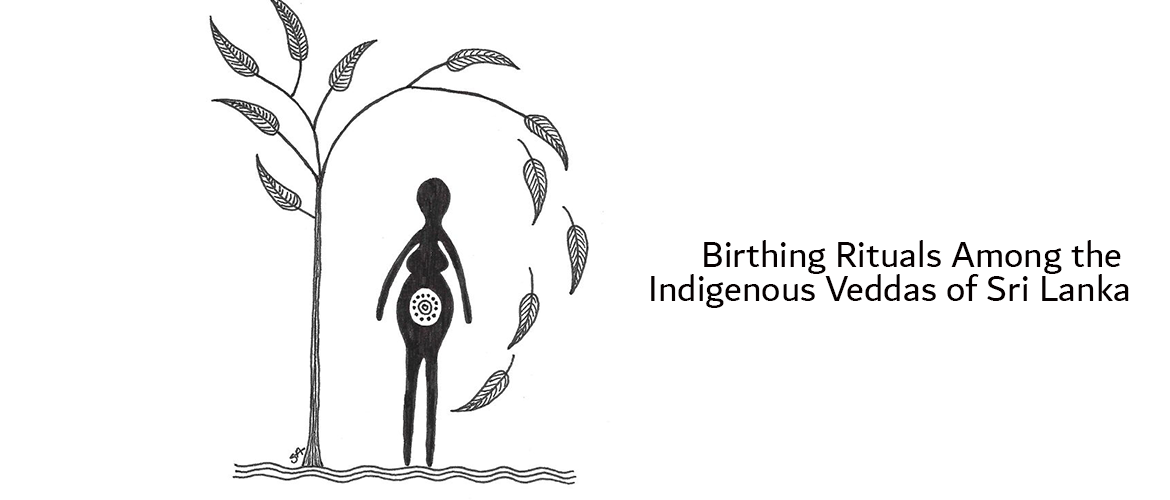In this study, I explore the traditional birthing practices among the Vedda communities of Henanigala and Yakkure, focusing on the ways these indigenous beliefs have survived, transformed, or faded under the pressures of development, displacement, and Sinhalisation. The narratives gathered here are drawn from fieldwork conducted in 2017 to 2020, featuring in-depth interviews with women, elders, and traditional healers some of whom remain the last carriers of this knowledge.
Among the Yakkure the term many Veddas use to refer to themselves, pregnancy and childbirth are enveloped in a web of spiritual, ritual, and practical knowledge. Traditionally, pregnancy was not medicalised but ritualised. The spirit world was intimately linked with the health of the mother and the unborn child. Women avoided certain foods and places believed to be cursed or inhabited by malevolent spirits. They engaged in protective rituals, sought blessings from ancestors, and often relied on elder women, not doctors, for guidance.
Particularly significant was the role of the Patta Yak, a malevolent spirit believed to cause miscarriages or difficult births. To ward it off, pregnant women wore protective charms, and family members invoked ancestral spirits in nightly rituals. The household became a spiritually sensitive space loud sounds, quarrels, or disrespect to elders could ‘provoke’ the spirits and bring harm to the child.
Childbirth itself was a communal, women’s affair. It typically occurred at home with the help of older female relatives and traditional birth attendants. There was a rhythm to the process, a spiritual ecology within which the woman laboured, soothed by chants, herbal remedies, and the calming presence of kin. Men were excluded not out of taboo, but out of deference to a feminine spiritual authority believed to govern childbirth.
After the birth, placenta disposal and naming were not casual acts. The placenta, was buried with ritual care, and its placement in the earth was believed to influence the child’s health and character. Naming was not just a label but a rite an ancestral name, or one revealed through dreams, was believed to anchor the child to the lineage of the Yakkure.
However, these practices are increasingly fragile. Among the Henanigala Vedda, who were displaced in the 1980s due to the Mahaweli Development Programme, traditional knowledge is rapidly fading. Hospitals have replaced home births, and many young women express anxiety about ‘not knowing what our people did.’
What we see is not just a loss of ritual, but a rupture in intergenerational transmission. Traditional knowledge that once flowed through grandmothers and ritual specialists is now fragmented. Some rituals are remembered only as stories, others half-practised, and a few still surviving in hybrid forms, fused with Buddhist pirith or Ayurvedic advice.
Yet, within this decline is also resilience. A few elders still perform naming rituals, and a handful of women are reviving herbal practices. In the quiet persistence of these customs, we glimpse a cultural identity refusing to disappear completely.
This research is not only an ethnographic record—it is also an invitation to preserve what remains, to recognise the intimate connection between body, spirit, and land that shaped Vedda ways of being. Birth, in these communities, was not merely a biological event—it was a moment of cosmic alignment, a reaffirmation of belonging to the land, the ancestors, and the living community of the Yakkure.
👉 Read the full paper: “Birthing Rituals among Yakkure and Henanigala Indigenous People; the Veddas in Sri Lanka” published in the SAARC Cultural Journal: Special Volume on Rites of Passage, Journey Through Human Life (2023), to understand how Indigenous people construct their birthing rituals within religious belief systems.
Feature Image Courtesy: https://www.latrobe.edu.au/jlc/research/mother-and-infant-health/womans-journey

